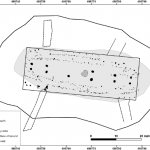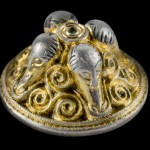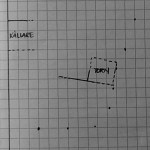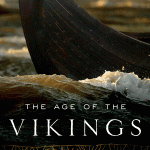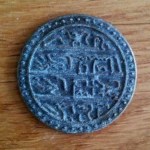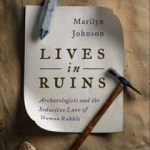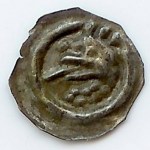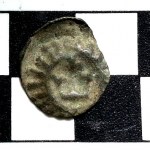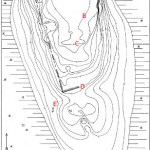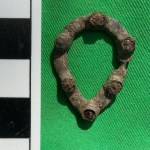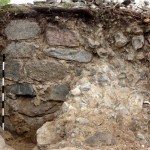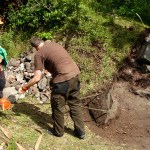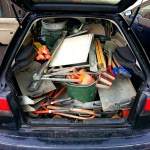archaeology
It's been a busy couple of days with a lot of publicity. Monday morning a paper I've co-authored with my friend, geophysics specialist Andreas Viberg, was published in the on-line version of Archaeological Prospection. For reasons of scientific priority (which I myself like to establish by spilling everything I do onto the blog immediately) I've been sitting on this since April of 2013, so it feels real good to finally blog about it. Here's a brief summary.
There's a huge weird barrow at Aska in Hagebyhöga near Vadstena in Östergötland. It's oval and flat instead of round and domed.
My old…
Apotropaic magic is designed to ward off or control evil. In vampire fiction, as well as in real life in cultures that include a belief in vampires, apotropaic objects might be crucifixes, cloves of garlic, etc. Apotropaic methods are known to have been used in burials. In the photograph above, a sickle blade has been placed across a person's neck at burial time, probably to keep them from reanimating and becoming all vampiry (Individual 49/2012 (30–39 year old female) with a sickle placed across the neck, from the paper cited below.) Some people have believed that a regularly occurring…
Pompeii situations, where daily life at a settlement has suddenly and catastrophically been terminated and the site has then been abandoned, are extremely rare and extremely informative. As has recently been discovered, the Sandby fortified settlement on the island of Öland offers a Pompeii situation from about AD 500. The settlement has been attacked, its inhabitants killed or abducted, and then the aggressors just closed the doors and never came back, leaving their victims and all their considerable wealth still inside the houses.
So far the Kalmar County Museum's excavations at Sandby have…
Landsjö castle. State of knowledge after the 2014 excavations.
I'm giving a talk on Landsjö castle to the Kimstad Historical Society next week, and while preparing my presentation I made a sketch plan of this summer's discoveries regarding the plan. The ruin just barely breaks the turf, so we didn't know much about the castle's layout beforehand except that it had a 60-metre straight stretch of perimeter wall along the west side and that it cannot have been rectangular.
Our main architectural discoveries in two July weeks of digging and clearing brush were as follows.
1. A wall divides the…
Anders Winroth (born in 1965) is a Swedish historian who received his PhD from Columbia in 1996 and now holds an endowed professorship in history at Yale. He has written several books on the Viking Period for lay readers, the latest one of which I've been given to review.
The main contents of The Age of the Vikings is organised into eight chapters on:
Raiding and warfare
Emigration and overseas settlement
Ships in reality and mythology
Trade
The development of political leadership
Home life in Scandinavia and the roles of women
Religion
Arts and letters
All eight are well written and…
I did a fun exercise with my Umeå archaeology freshmen Monday: a role-playing debate about the ethics of burial archaeology. The framework was a hearing at the Ministry of Culture regarding a planned revision of the Ancient Monuments Law.
I assigned randomised groups of up to 4 students roles as archaeologists, neopagans, the Swedish Church, a housing development firm, Satanists, Saami nationalists and recently arrived Syrian Orthodox Turks. Each group got a slip of paper telling them what their opinions were about burial archaeology, above-ground curation of human remains and reburial. I…
Fornvännen 2013:4 is now on-line on Open Access.
Ulf Ragnesten on an ornate late-1st millenium BC bronze chain belt from a cremation grave in a Gothenburg suburb.
Lars Larsson and Bengt Söderberg on recent excavations at the huge 1st millennium AD royal manor complex of Uppåkra, with in situ arson victims found among the building remains. (Just like what has more recently been found at Sandby fort on Öland!)
Pia Bengtsson Melin on recently found Romanesque mural fragments in Marka church in Västergötland.
Anders Högberg et al. on scientific characterisation of flint from Polish and South…
Here's a neat case of self-perpetuating archaeology. Medieval history spawned sword & sorcery literature. This literature spawned tabletop fantasy role-playing games and Medieval re-enactment groups. These games and groups spawned live action role playing. And now the larpers have created a market for faux-Medieval coinage, which they are buying at game stores, using at larps and dropping here and there. Metal detectorists are starting to find coins like the one in the picture and submitting them to intrigued museum curators.
Can anybody tell me the name of the company that makes/made…
I've read Marilyn Johnson's forthcoming book Lives in Ruins. Archaeologists and the Seductive Lure of Human Rubble. It's a collection of lively and enthusiastic portraits of contemporary archaeologists in their professional environment. Some may find the tone a bit too enthusiastic, pantingly so in parts, but that's a matter of taste. Archaeologists should arguably be thankful to have a friend like Marilyn Johnson.
Still, she's an outside observer of our tribe, and she approaches us from a very particular direction. Take her introductory statement that “Field school … usually takes place in a…
The library of the Royal Swedish Academy of Letters is (one of?) Scandinavia's biggest research library (ies) for archaeology, the history of art and allied disciplines. Since it's co-located with the archives of the National Heritage Board in the East Stable next to the Swedish History Museum, it's an amazing place to do research. And it just got even better.
Librarian Annika Eriksson tells me they have been working on this for quite some time, and now they've got it up and running. The library's assortment of commercial digital resources – notably hundreds of paywalled research journals –…
Deep in a single square metre of trench D at Landsjö castle, on the inner edge of the dry moat, we found five identical coins. Boy are they ugly. They're thin, brittle, made of a heavily debased silver alloy and struck only from one side; they bear no legend and the image at the centre is incomprehensible. But I love them anyway, because they offer a tight date: this coin type was struck for King Valdemar Birgersson c. 1250-75. And the first written mention of Landsjö dates from 1280, so it all works out.
Valdemar became king because he had an extremely powerful and ruthless father, the jarl…
A fun thing about historical archaeology, the archaeological study of areas and periods with abundant indigenous written documentation, is when the archaeology challenges the written record.
According to the patchily preserved historical sources, Landsjö hamlet was a seat of the high nobility in about 1280 but then became tenant farms no later than 1340. This means that the castle on Landsjö islet was probably in good defensible shape and inhabited in 1280 but not after 1340.
During last week's excavations we found a previously unknown strong wall delimiting the castle's high inner bailey,…
Christian Loven's plan of Landsjö Islet with letters marking on-going fieldwork.
Landsjö castle is on a high islet in the lake next to the modern manor house. Nobody ever goes there. The ruins are covered by vegetation and they're in bad shape: only along the western side of the islet do they rise even a metre above the rubble and accumulated forest mulch. Visible is a 59-metre N-S stretch of perimeter wall with a preserved corner at either end, and a shorter W-E stretch of perimeter wall from the south-western corner. Along the inside of the visible wall are vague suggestions of two…
With two days of digging and one day of backfilling left at Stensö Castle, trenches A and B have already given a rich harvest of new information.
The northern tower was a green ruin mound when we came to site. We now know that the tower was built entirely of greystone, it was round with a diameter of about 5.5 m, and it was planned and built together with the perimeter wall. The lost western half of the latter did not join the tower on a radial line. Instead more than half of the tower's circumference was outside of the perimeter wall, allowing flanking, where bowmen in the tower could strafe…
Compare the disc from Stensö to these "fairy stone" calcium carbonate concretions from the Harricana River in the Abitibi-Témiscamingue admin region, Quebec, Canada. The Stensö piece has been sanded smooth and flat on one side. Locally these things are known as marlekor or mallrikor.
Thanks to project advisor Lotta Feldt of the Östergötland County Museum for setting me on the right track.
After four days of rubble removal in trench A, we found the south wall of Stensö Castle's northern tower. Note how the wall facing (left) ends, and a pale mass of wall core (lower right) emerges out of the tower. This is the castle's previously unseen western perimeter wall.
Our first week of two at Stensö is over, and already Chris, Fanny and Simon have made trench A answer the question we've asked of it. Way back in line with the trench's top edge on the flank of the northern tower's ruin mound, they've uncovered a neat wall face of dressed ashlar, and out of this tower wall projects an…
Medieval walls are usually shell walls, where you construct an inner and outer shell of finely fitted masonry while filling the space between them with a jumble of smaller stones and mortar. Usually the facing stones don't project much into the core. When the wall is allowed to erode, once the cap stones have fallen off, the facing starts to peel from the core one ashlar or brick at a time from the top down. Before the resulting rubble layer's top (rising) reaches the level of the wall's eroding top (descending), halting erosion, you'll see a ruinous wall that is thick and smooth-faced in its…
Stensö castle, trench C, the part along the perimeter wall. Note the ashlar.
Drove down to Vikbolandet on Sunday night with my excellent colleague Ethan Aines from Stanford, and we were met at expedition HQ by seven of my Umeå students from last autumn semester. Very pleased to see them again! They've just finished their second term and several are scheduled to go on to the third. So I'll be seeing them in the halls in September when I take on my second batch of Umeå freshmen, and if I'm lucky I'll get to supervise a few of them for their BA theses. Everyone's being charming and nobody…
It's Sunday morning and I'm getting ready for four weeks of excavations. I haven't done any digging since the Pukberget cave dig in 2011, and my last multi-week dig with a big team was at Sättuna in 2008. So it's high time, and I'm excited. Getting stuff from my study, packing stuff at home, buying some extra tools and a lot of food.
My crew of ten will be assembling at a farm-labourers' dorm in Östra Husby starting tonight, and tomorrow we break turf at Stensö castle ruin as the first archaeologists to dig there. Most team members are first-year students from Umeå whom I taught during the…
I've blogged before about becoming an archaeological dad, when new work built upon and superseded stuff I did in the 90s. Now stuff I did in the 00s has become, if not history, then at least museology, in the pages of Dr. Carl-Johan Svensson's PhD thesis in didactics (freely available on-line as a 2.4 MB PDF file). He presented his thesis yesterday at the School of Education and Communication, Jönköping University.
Ten years ago I was involved a drawn-out and pretty violent public dispute about the policies of the then director of the Museum of Swedish History – which is misnamed because its…
